It’s fair to say that at the beginning of the season, very few people, if any, would’ve predicted the UEFA Europa League final being disputed between Eintracht Frankfurt and Rangers.
However, on Wednesday, the two clubs steeped in menacing history took to the field in the Ramón Sánchez Pizjuán Stadium to contest the prestigious trophy.
There was something fitting about the final being held in Seville, in the arena that currently holds Sevilla’s six titles – the most of any club in the competition’s antiquity – in a match comprising two sides with just one piece of European silverware between them, now two.
The stage was set. It was Scotland versus Germany, Dutch coach versus Austrian. As the blistering sun began its bovine descendent, churning day into night in all its mundane predictability, the two teams kicked off what would be the biggest match of the players’ careers. Unfortunately, there could only be one winner – and it was Eintracht Frankfurt on penalties.
Oliver Glasner’s side rejoiced when the final penalty flew into the net, as Rangers players fell to the ground in despondency and despair – football in its purest, cruellest form.
But let’s take a look at exactly how the game was won and lost tonight. This will be a tactical analysis piece on the riveting Europa League final. It will be an analysis of the tactics that were crucial to Eintracht Frankfurt’s formidable feat.
Lineups and formations
If it isn’t broken, don’t fix it. A wonderfully relevant mantra in the world of football when it comes to managers picking the eleven players to start a game as well as the formation. This principle is adhered to by the likes of Jurgen Klopp and Antonio Conte but often scoffed at by the Pep Guardiolas and Graham Potters of the industry.
The imperfect phrase is incredibly appropriate for this Europa League final.
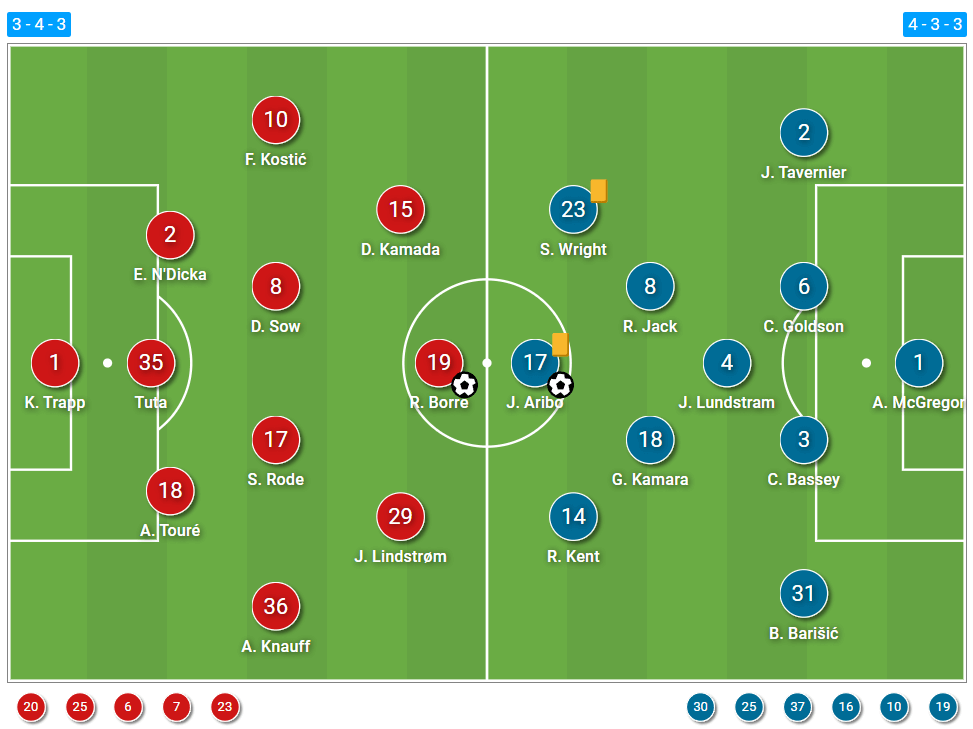
Eintracht Frankfurt made just one change to their starting lineup for this colossal clash from their previous outing against Mainz at the weekend, with Glasner maintaining the side’s 3-4-3 formation in the meantime.
Jens Petter Hauge dropped to the bench to make way for Jesper Lindstrøm who started on the right of Die Adler’s fruitful front three.
Meanwhile, Giovanni van Bronckhorst took a different approach than his predecessor. Back three systems have served Rangers inexplicably well over the course of their mesmerising European barrage. Regardless, ever the tactician, the Dutchman switched things up.
The Gers set up in their preferred 4-3-3 in Seville as the head coach believed that this would give his team the best chance of attacking their domestically lamentable opponents.
Rangers’ personnel was unchanged from the lineup that deservedly put RB Leipzig to the sword a fortnight ago. The only difference was that John Lundstram pushed into midfield, instead of remaining as a centre-back, to create the 4-3-3 structure, sitting just behind Glen Kamara and Ryan Jack who played in more advanced roles.
Now, let’s take a look into how the two different tactical systems matched up against one another.
Why the formation change from Rangers?
Typically, van Bronckhorst only shifted to a back three in games where Rangers would be the antagonists, looking to defend their goal for large parts of the game. However, by switching to a 4-3-3, the 47-year-old showed a clear prediction that his side would be the protagonists.
Viewing the game’s data on Wyscout, the first half certainly panned out exactly how van Bronckhorst would have expected, with Rangers being the dominant side on the ball.
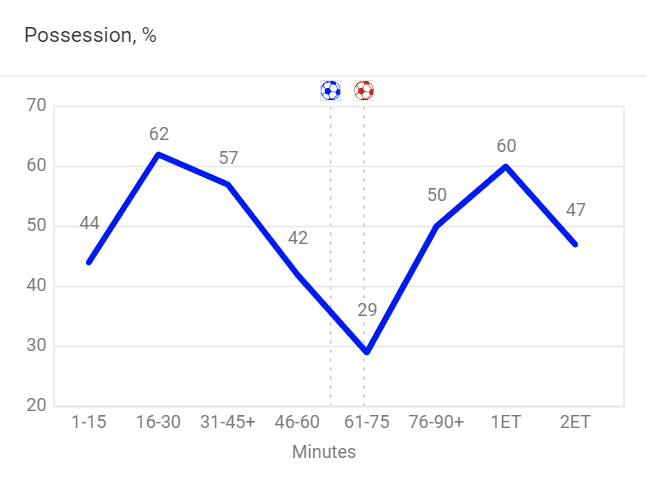
In the first half, Rangers averaged 54.3 percent of the possession share as Eintracht Frankfurt were perfectly comfortable allowing the Scottish giants to keep the ball in low-risk areas of the pitch.
Van Bronckhorst would have expected his side to be much more willing to get on the ball and knock it around because of Eintracht’s tendency to sit back and defend in a deep defensive block which is how they managed to upset the apple cart by smiting Barcelona in that infamous 3-2 victory at the Camp Nou.
The 4-3-3 gave Rangers a lot of balance in possession because they used the three forwards to pin Eintracht’s back five while the central midfielders occupied positions between the lines.
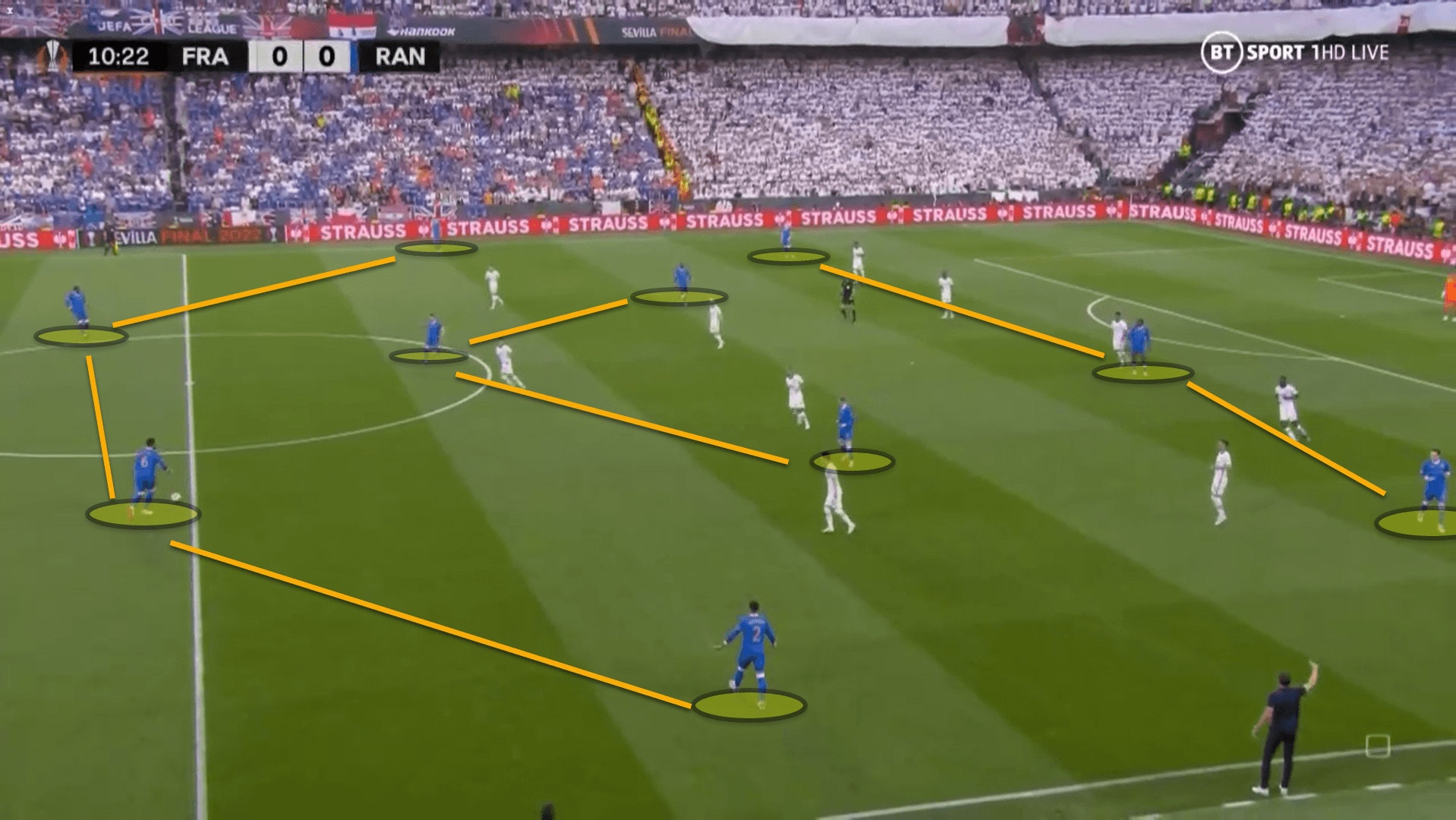
Here, the 4-3-3 shape is very evident, although like all teams that play this conventional structure in possession, it rarely ever remains a constant.
For the most part, Rangers’ right-back James Tavernier would bomb on down the right flank with Scott Wright, the right-winger, tucking inside into the halfspace. Quite often, this would create 1v1 situations down this side, and the Gers would try to find Tavernier with a chipped ball in behind.
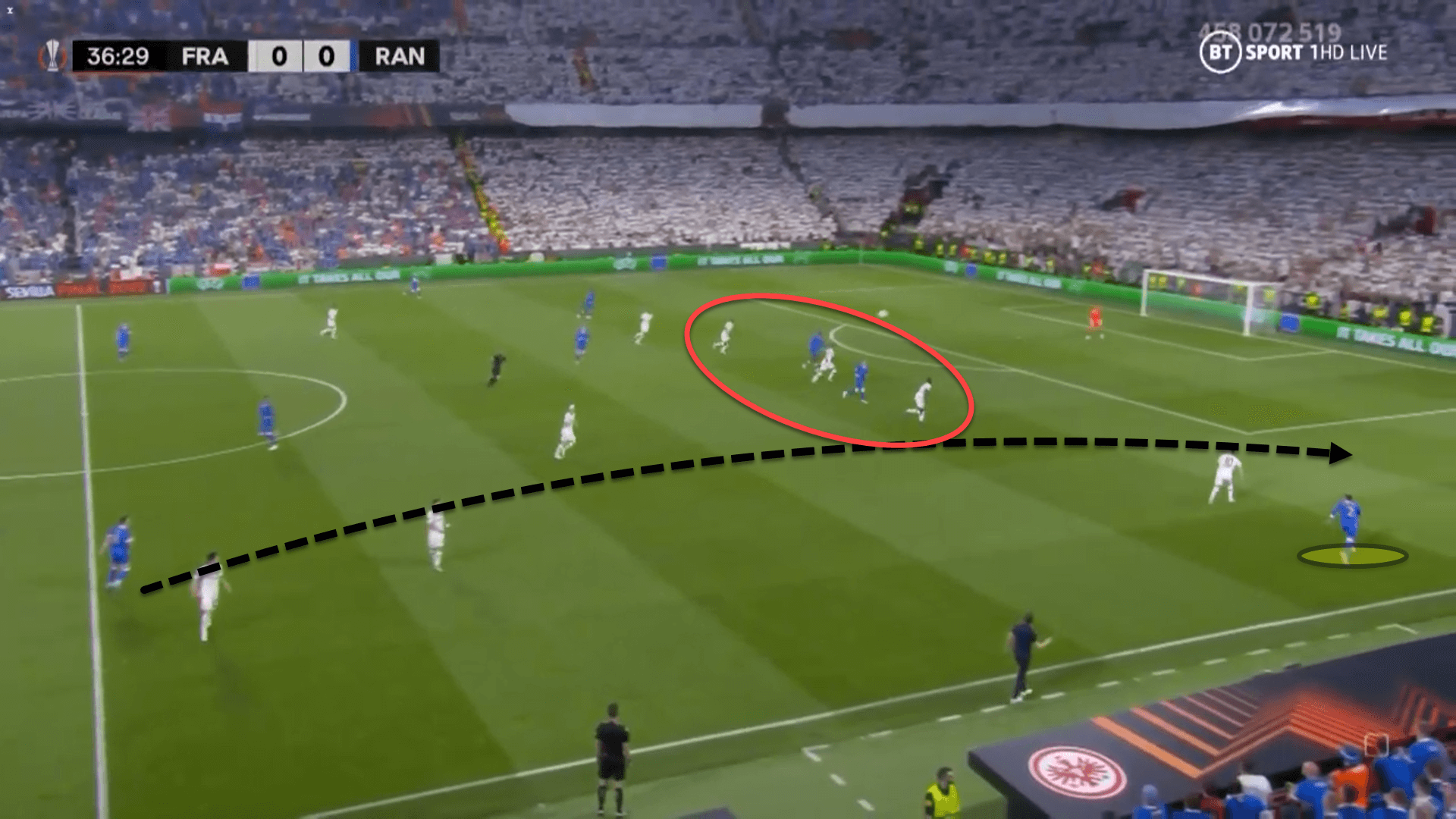
This was a move that almost came off for van Bronckhorst’s men. Wright moved centrally alongside Joe Aribo as the pair occupied Eintracht Frankfurt’s three centre-backs at once, leaving the German side’s wingbacks isolated against Tavernier on the right and Ryan Kent on the left.
The right-back got into a good position to cross but failed to pull the trigger. This became a common occurrence for Rangers.
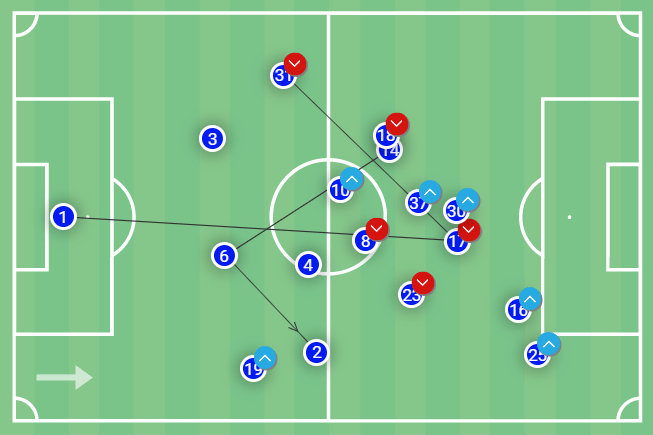
This pass map displays all of Rangers’ most-utilised progressive passing links throughout the Europa League final. Switches of play from Connor Goldson to Kent and Tavernier comprised two of their four prominent progressive passing networks.
Ideally, Tavernier and Kent would have won their individual battles and hit bucket loads of balls into the area. However, Rangers ended the game with merely 11 crosses in total. Only 4 were accurate.
Rangers struggling to break Eintracht down
While switching the play, trying to isolate Eintracht’s wingbacks against Kent and Tavernier, was a useful ploy by Rangers, van Bronckhorst also wanted to try and break them down centrally by playing inside the team’s defensive block.
However, Glasner’s men were extremely resilient throughout, conceding an xG of 1.48 across the entire 120 minutes of football. Eintracht’s 5-4-1 low block worked a treat and really stifled Rangers’ ability to create many clear-cut chances.
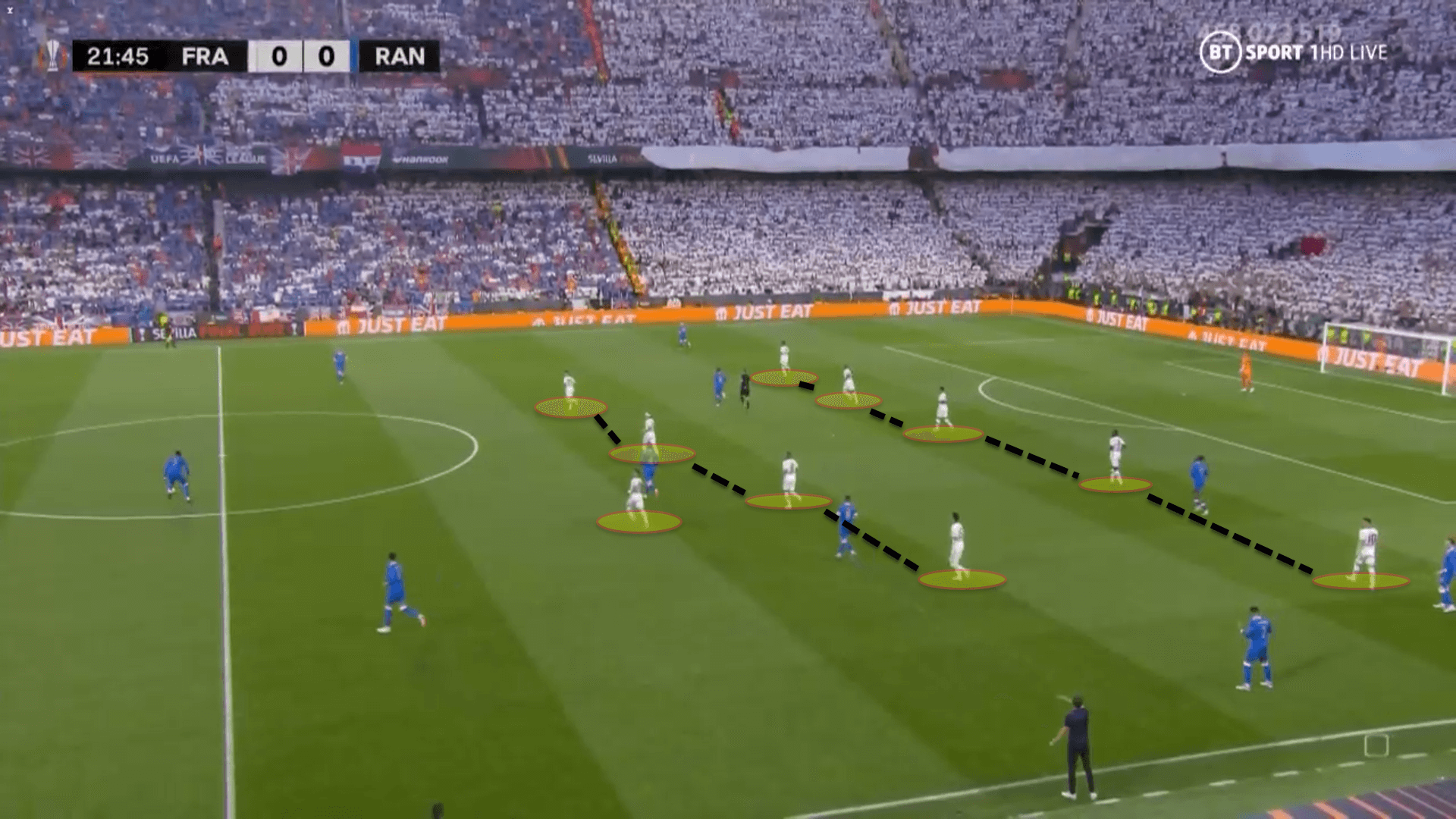
Eintracht Frankfurt remained extremely compact between the lines, ensuring that Rangers were unable to manoeuvre the ball into dangerous areas. Instead, Glasner’s side were content with ceding possession to their opponents for large parts of the game.
This was particularly evident in the first half when Rangers had more of the ball. Eintracht Frankfurt’s Passes allowed Per Defensive Action (PPDA) graph for the game also backs this up.
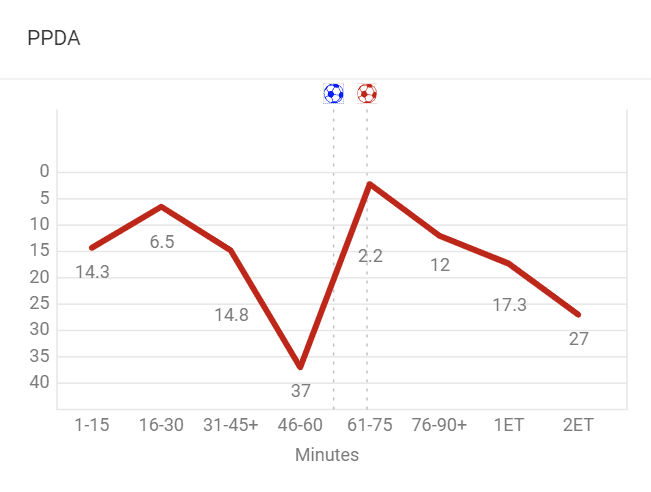
Throughout the entire match, including both halves of extra time, Die Adler boasted a PPDA of 11.13, but this was highly inflated by the few minutes after Rangers scored when the Germans kicked it up another three gears before equalising.
Eintracht Frankfurt employed a zonal defensive structure. This means that the players remain very compact vertically and horizontally, and work cohesively to cut off any passing lanes inside their defensive block.
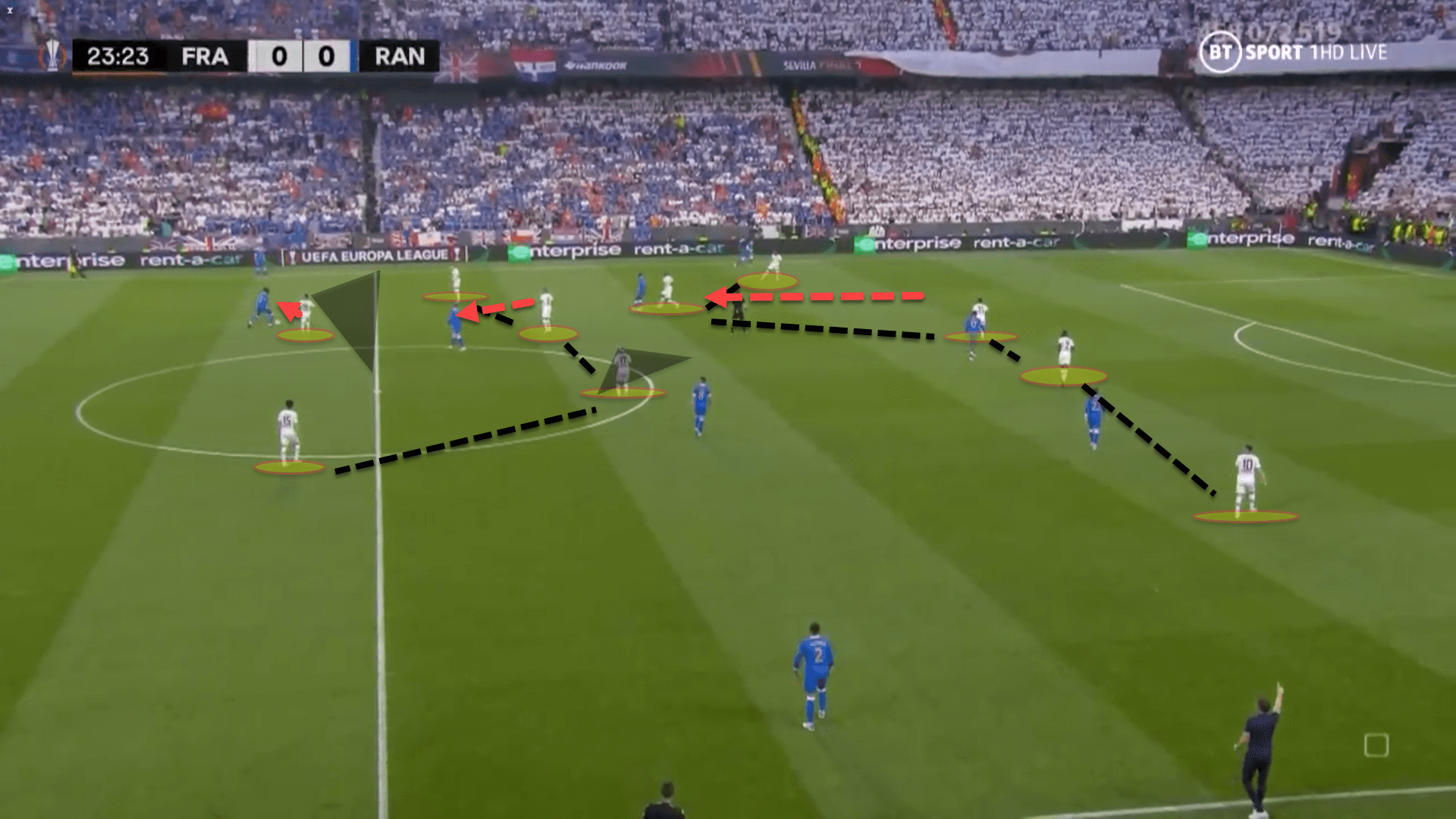
This involved the central defenders being aggressive in closing down players receiving the ball between the lines. In this image, Almamy Toure has stepped out of the defensive line to put pressure on Kamara before the Fin gets the ball and turns on it.
It was the double-pivot’s job to block the passing lanes into this area but if the two midfielders were preoccupied, the centre-backs would then push up to help cover any options.
In their stubborn low block, Eintracht would entice Rangers to play out to the flanks where they would press more aggressively to regain possession, often ganging up on the ball player in 2v1 situations.
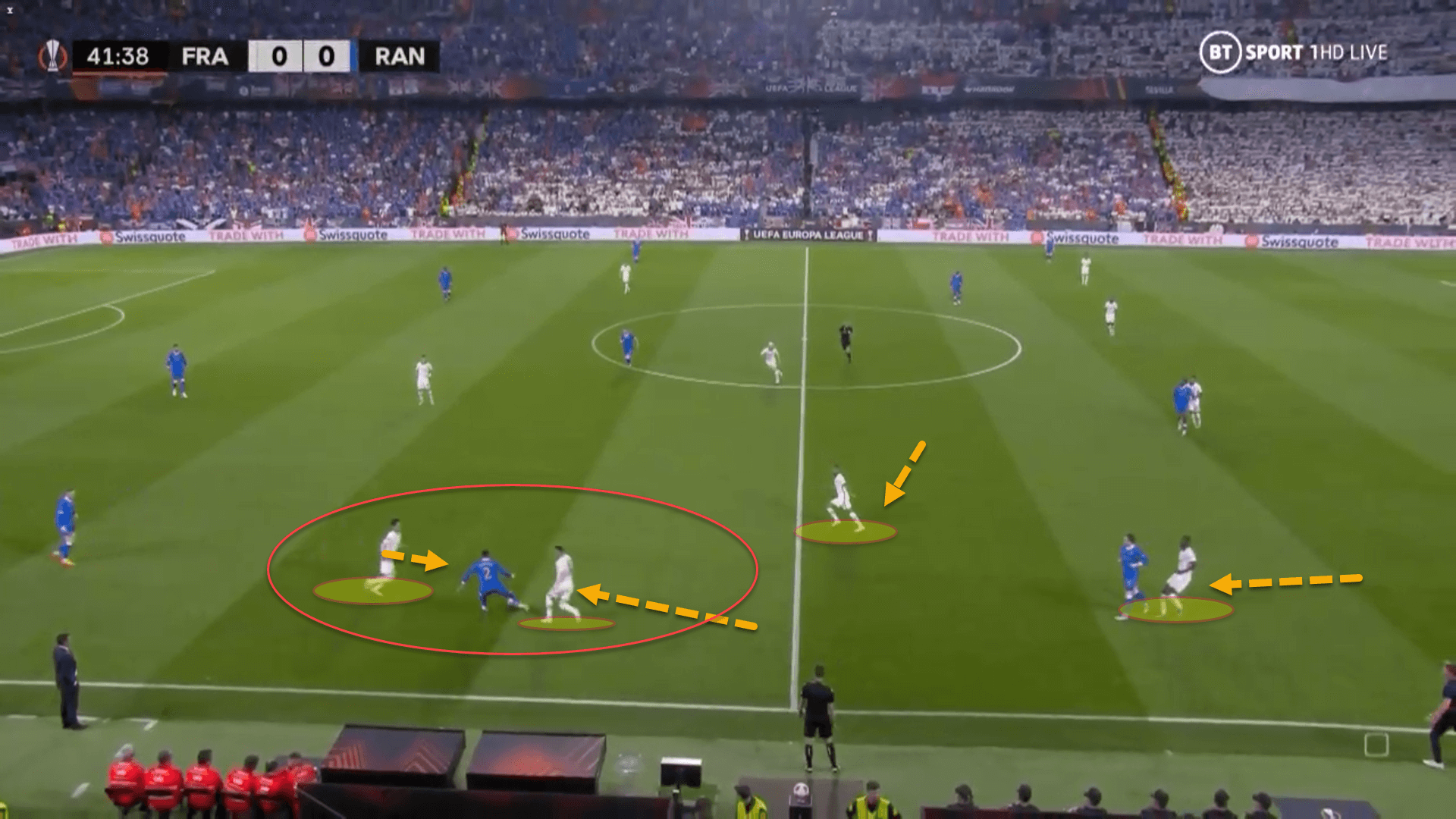
Across the entire game, 83 percent of Eintracht Frankfurt’s defensive duels were in the wide areas. From their 97 contested defensive duels, Glasner’s side came out on top in 59 percent of them which is quite a solid ratio.
Looking at a plotted map of the locations for these duels, quite a high volume were in the defensive third of the pitch, where Eintracht would be the most aggressive in order to stop crosses and combination play from breaking down their block.
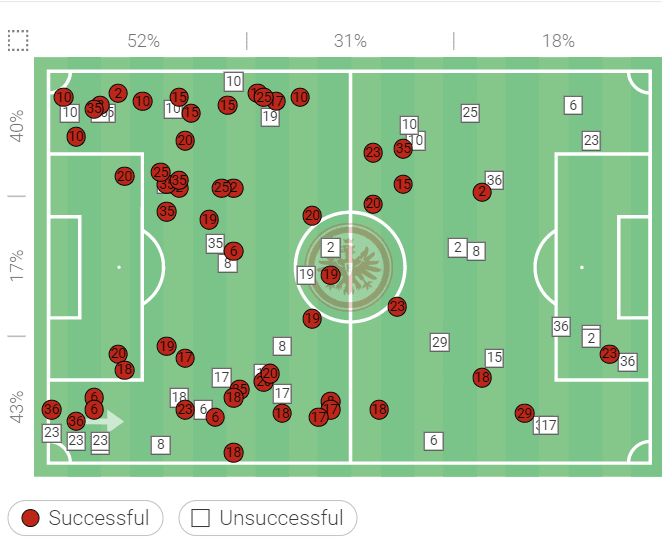
Once the eventual winners won back possession of the ball, their ploy would be to quickly play it to the tricky winger Filip Kostić, who was deployed as a wingback for this game.
Kostic is a wonderful carrier of the ball, capable of dribbling past anyone on his day. The Serbian was a huge asset for Eintracht in transition as Tavernier’s high positioning meant that there was space to attack down his side once the ball was regained.
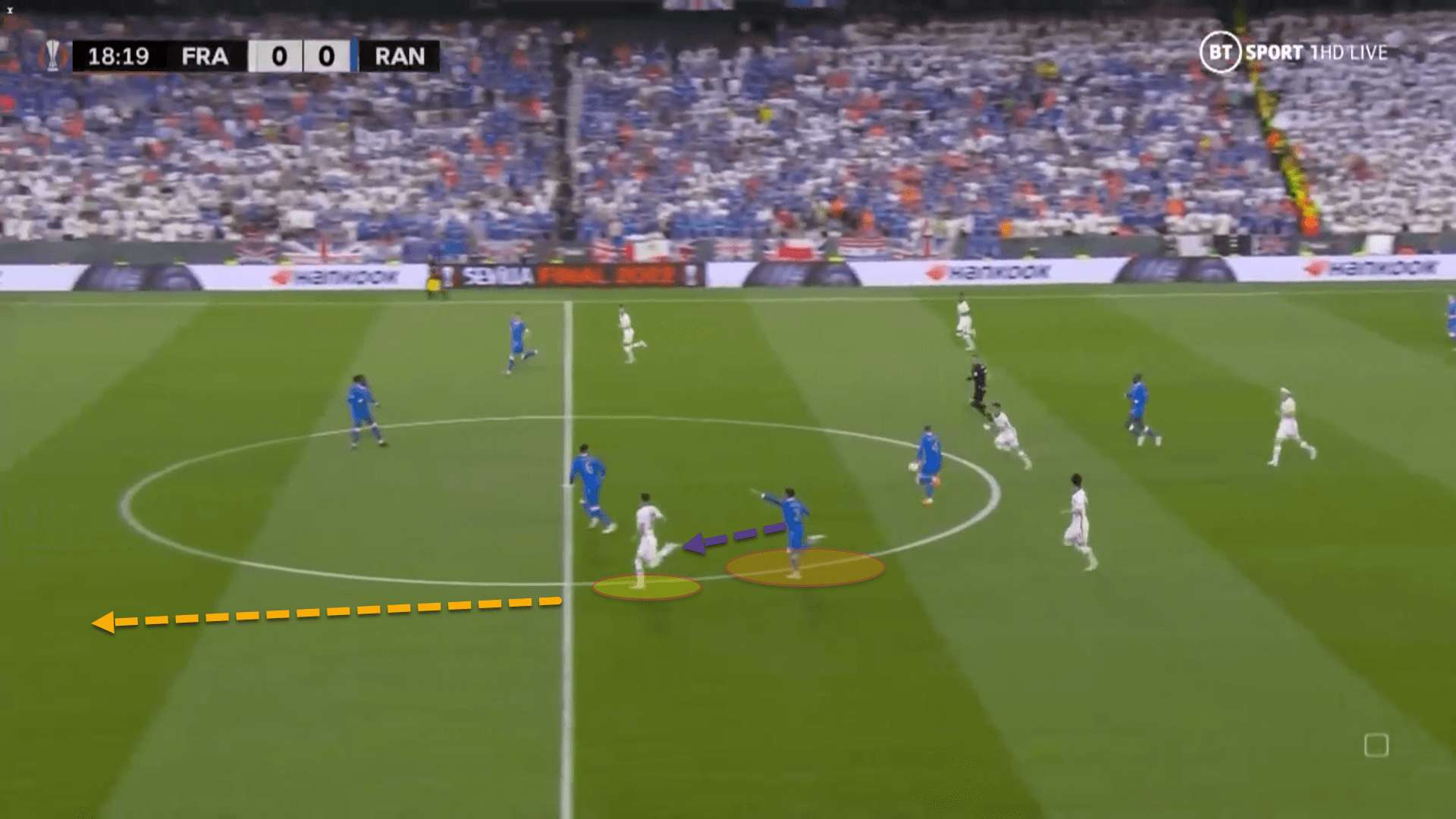
Kostic was quite impactful on the game overall. The 29-year-old makeshift wingback even provided a superb cross for Rafael Borré which allowed the nippy Colombian to get in between Rangers’ two centre-backs and poke the ball past Allan McGregor for the equaliser.
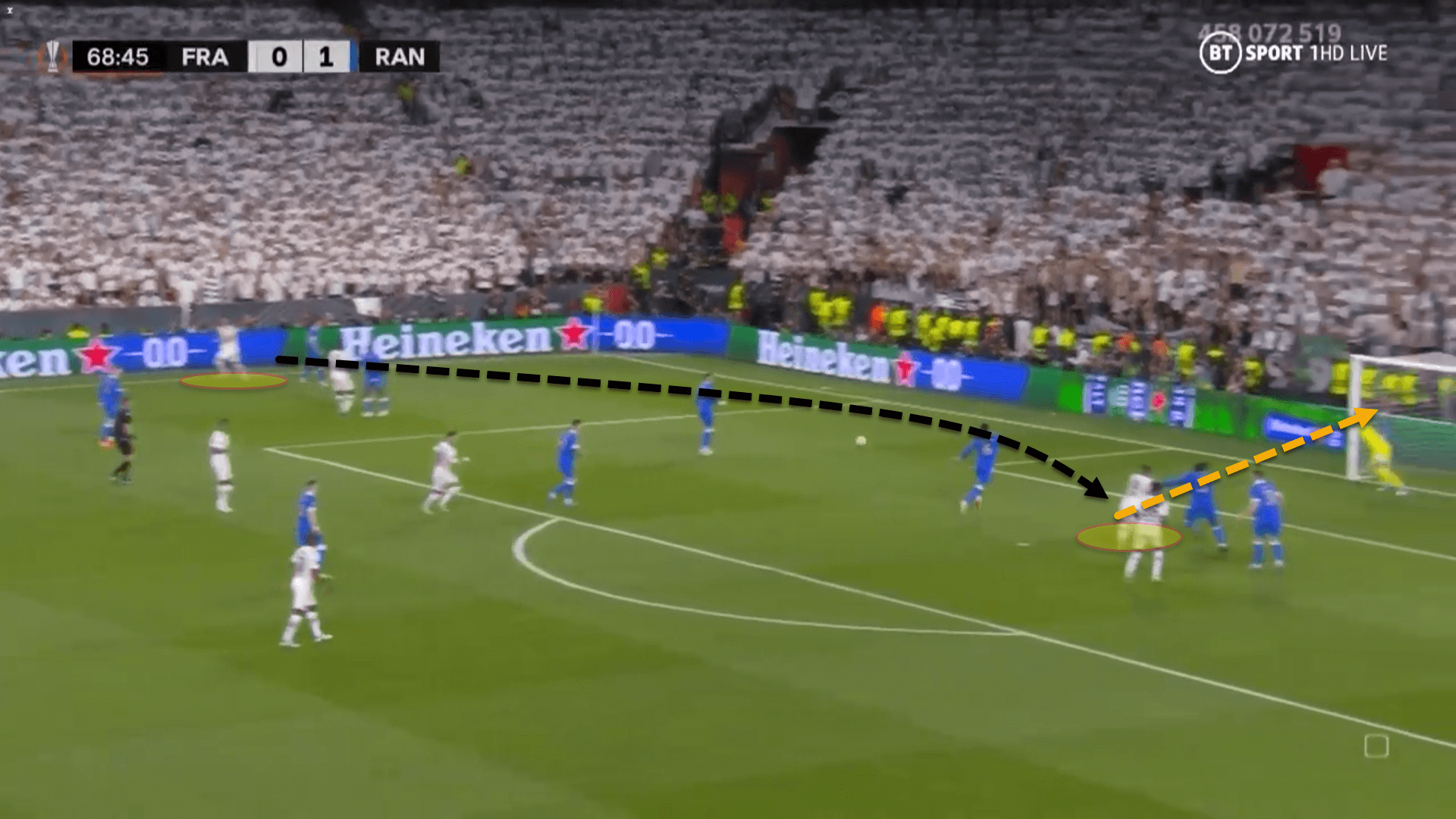
Rangers reversion
The switch to a 4-3-3 didn’t fail for Rangers. Ultimately, van Bronckhorst’s side didn’t create many clear-cut chances, but they had managed to go toe-to-toe with Eintracht Frankfurt, having more possession than the Germans.
However, the Dutch coach needed something different from his players. Originally, Rangers switched to a 4-2-3-1, pushing Kamara further forward as a number ‘10’ while Jack and Lundstram became the double-pivot. But when extra-time kicked off, the manager changed his side’s shape for the third time.
Lundstram dropped back into the defensive line with Gers restarting in the 3-4-3 that served them well against RB Leipzig in the second leg of the semi-final tie.
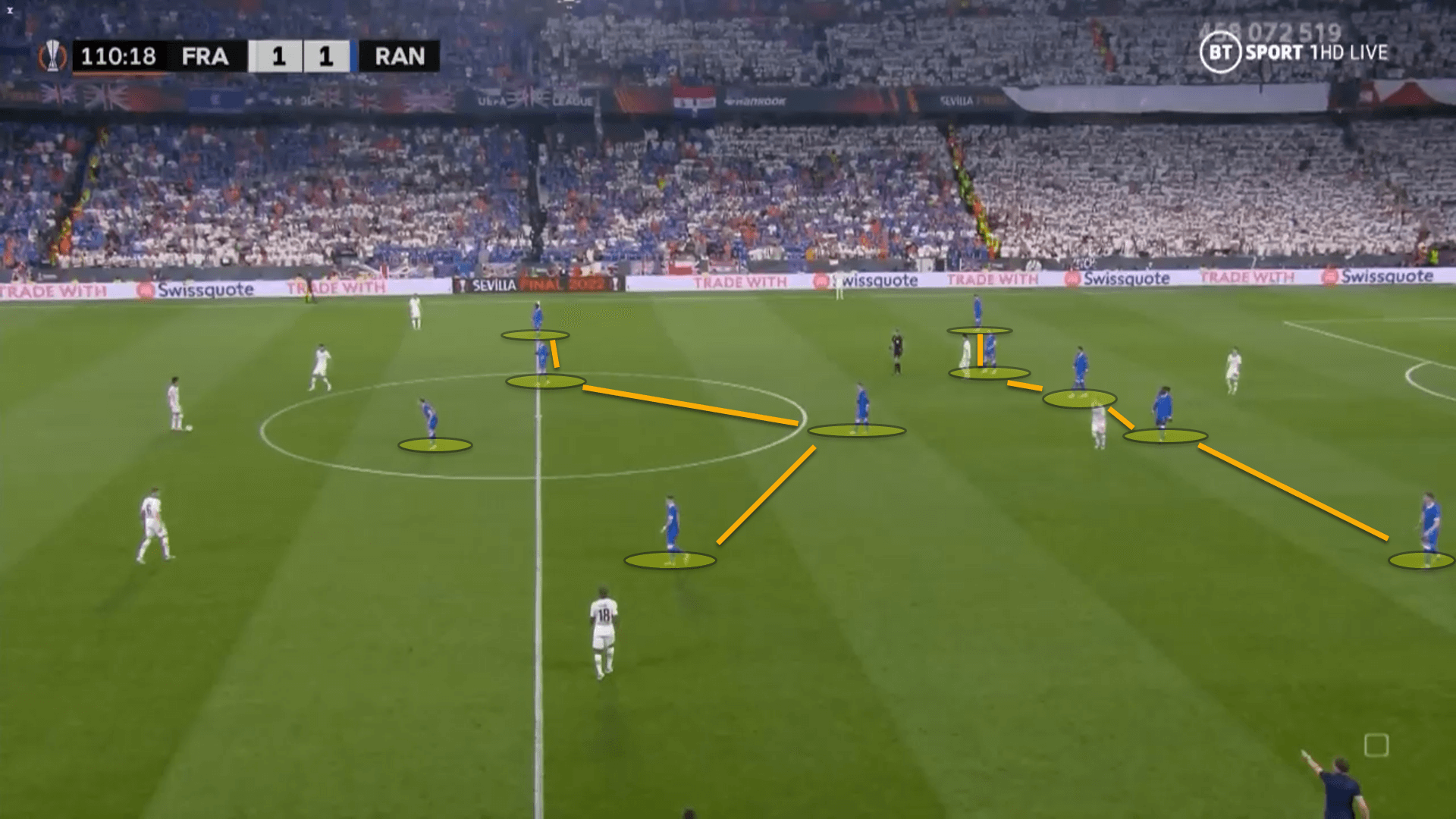
As Eintracht were still keeping their 3-4-3 shape in possession, Rangers’ structural shift, if nothing else, allowed them to match-up against their German opposition.
The game became much more man-oriented as the 3-4-3 matches up perfectly against another 3-4-3. While defending, both teams were simply man-marking instead of playing zonally, leaving the remainder of the final to come down to a battle of the individual duels.
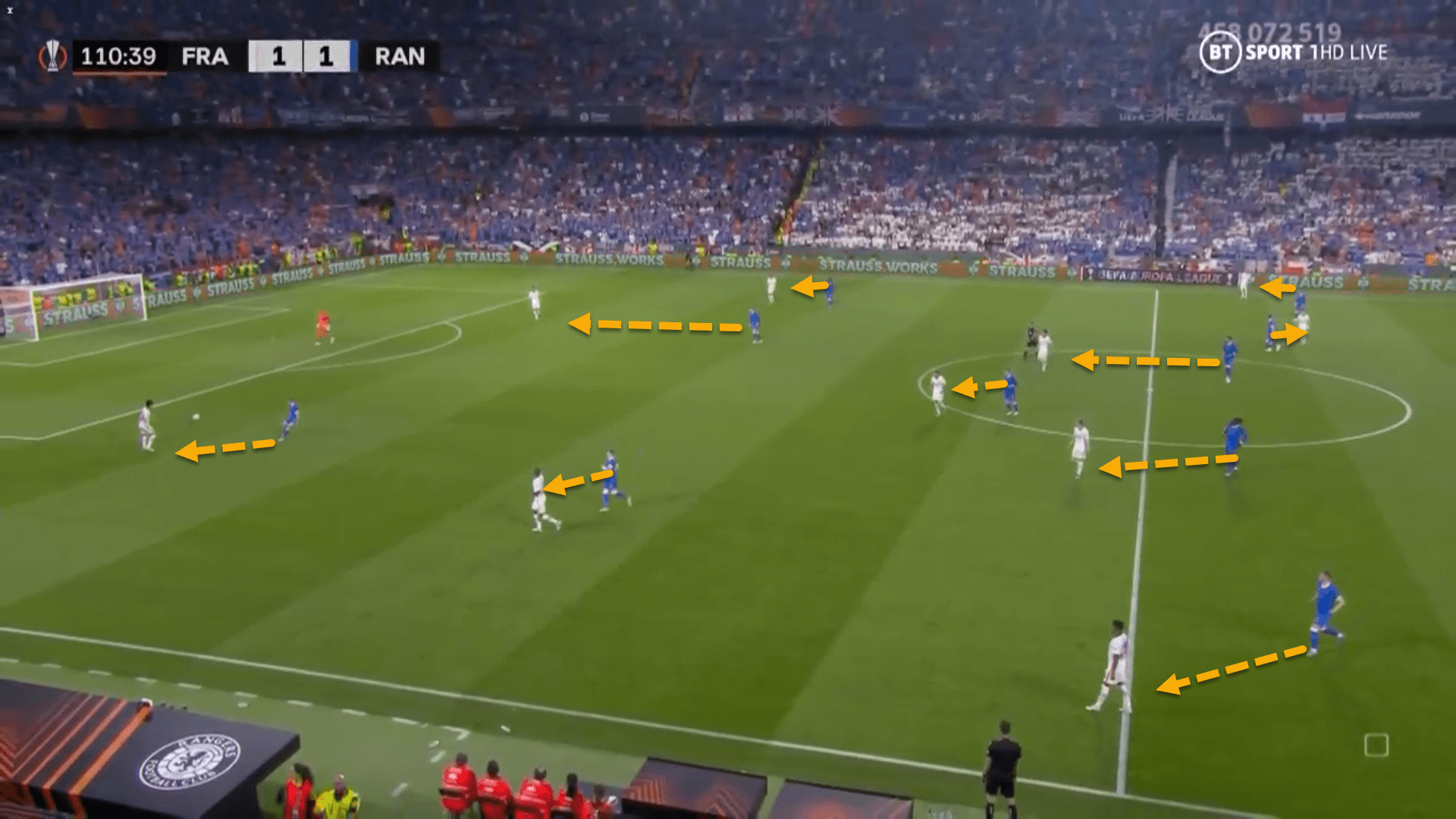
In this example, Rangers are pressing Eintracht Frankfurt high up the pitch as Glasner’s men look to build out from the back. Van Bronckhorst’s team are completely man-oriented in their high-press, with every outfield player picking up someone from the opposition.
It’s fair to say that this approach worked for Rangers. Die Adler really struggled to create any more chances, particularly during extra-time, and so the game was taken to penalties, football’s wickedest wager.
Conclusion
Having gone the distance, fighting their way through the group phase, swatting aside any superior team that looked to kill their joy, Rangers lost the final through a penalty shoot-out. Chelsea know the feeling all too well.
Despite their domestic faults and flaws, Eintracht Frankfurt were victorious after a heavily-fought contest between two evenly-matched teams on the night.
As Borre smashed his penalty into the top-left corner, the Ramón Sánchez Pizjuán was sent into pandemonium, as well as despair. There were tears of joy. There were tears of sadness. Some were in a state of euphoria, others stared into hell’s daunting abyss of oblivion, showcasing why football is the most brutal, yet brilliantly beautiful game on earth.






Comments